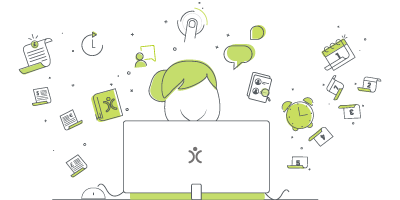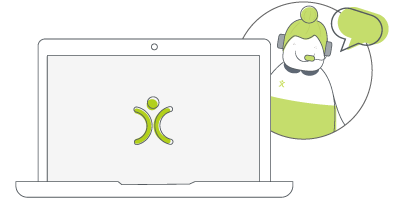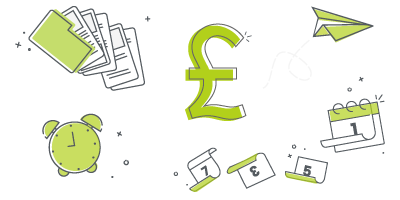Sales Force Automation and CRM: Answering your questions
14 Jun 2021
I’d like to start this blog with a quick definition of what Sales Force Automation (SFA) is…and then explore how it relates to Customer Relationship Management (CRM) solutions.
Sales force automation is, at its most basic, a collection of tools you can use to automate, streamline, and generally manage your sales process (and team).
These could be anything from automated email scheduling and sending, notifications and reminders, automatic task and call scheduling. All the way through to updating and even creating dependant records.
After all, you don’t want your salespeople only spending 33% of their time actually selling your product! Sales force automation tools (and CRM systems more generally) should be helping to reduce all of that administrative stuff they’re doing 66% of the time. Giving them more time to focus on their actual sales.
Sales Force Automation and CRM
Did I mention CRM? Of course I did! Did you know that most CRM systems have sales force automation tools built right in? These are just part of their overall wheelhouse of business management features.
Now there are also dedicated SFA solutions out there. Ones that don’t have CRM elements as part of them.
In short, not all CRMs have great SFA tools and not all SFAs are part of CRMs.
Sales force automation can be a powerful tool. But (and this is entirely my opinion now) I don’t think it is something that should stand alone.
I have always felt (even before I started a CRM company) that putting up barriers between your sales team and the rest of your business is a mistake.
Of course you want to keep certain things separate (the money specifically), but a good CRM system will have permission tools to let you do that.
Benefits of a CRM with SFA tools
The benefits to incorporating your SFA with your CRM, in my mind, are twofold:
- Full customer history
- Collaboration
When a customer’s entire journey is in one place, from sign up to after care, everyone coming into contact with that person will understand how your relationship with them works. Your support team can find out what they were originally looking for when they found your product. The sales team can see how many questions they’ve asked your customer service team before chasing an overdue invoice.
This leads me into my next point: collaboration. By letting people see the whole customer journey, you make it easier for different teams to brainstorm and work together on projects. This teamwork will make your business that much stronger.
There are probably lots of other benefits to keeping your sales force automation as part of your CRM system. But I’d like to leave it there and move sideways a bit. So let’s talk about the WHY of SFA tools in particular.

Do we have what it takes?
We don't restrict which features you have access to in OpenCRM based on how many users you have. You get everything right out of the box. Click to find out if we've got the features you need.
find out moreGoals of Sales Force Automation
When a business is shopping around for a tool to help manage their sales team and processes, what are they actually trying to achieve?
Well…besides the obvious goal of increasing revenue by freeing up salespeople’s time.
In most cases (I find), the first pain point that brings people to us seeking SFA tools is a level of confusion within the sales team. Then, while you speak to them, little complaints about HOW LONG everything it takes them to do stuff in their current system or process.
And finally, often in the last few minutes of a call, the question of oversight comes up. Most managers I know don’t want to spend their lives looking over the shoulders of their team. They trust them to get the job done. But when they do want the facts and figures, these managers don’t want to spend days trying to get all the relevant data together.
I’d like to go through each of these elements in more detail. Speaking a little bit on what the problem is and touching on how sales force automation tools can help.
Keeping the Focus of your Sales Team
When it comes to keeping your sales team on task (and on the right task) and motoring through their to do list, I like to break this down into three key elements:
- Doing the right tasks,
- Acting on the right opportunities,
- And seeing the right information
All of these things have to, of course, be done at the right time.
This means your SFA tool needs to be presenting the relevant information to your sales team. Bringing it to their attention. This means that only the person assigned to a particular Lead or Contact is seeing it (and messaging them). It also means that people are aware which of their Opportunities are getting near to their close date or which have been open for longer than usual.
All of this together can really work to focus your sales team. Instead of just dipping into a random record at the top of their list, they know that the item at the top of the list needs some attention.
Automate the Boring Stuff
Let’s be honest (and I’m speaking as a salesman myself here), but salespeople aren’t great when it comes to the detail. Of course we all know exceptions to the rule, but as a group, they tend to want to speed through their tasks. Getting stuff done, and getting the money in the bank.
Personally, I’ve always thought that it’s a little like adrenaline junkies…they love that rush of winning a sale. So sometimes they towards it instead of making sure all their safety equipment is in perfect working order.
In sales, however, too often this means that your customers miss out on important information. Or don’t get that 6 monthly follow up call to check in. Your sales team aren’t deliberately leaving people out, they just forgot to do the little job that makes sure that follow up call gets scheduled.
Great sales force automation tools will do exactly what they say on the tin: they will give you tools that let you automate some of your sales team’s jobs.
This means things like follow up Activities getting created automatically, drip emails sending out on the right date, Opportunities updating when new Quotes are sent out, Contracts created when a Sales Order is signed, etc.
This keeps your salespeople from getting bored (or forgetful) when it comes to the admin side of their job. It also makes sure your customers don’t suffer for it.
Insights and Reporting
And finally, one of the big benefits to sales force automation tools is the oversight they give you. I’m talking about pipelines, reports, and graphs that let you know how your sales team is doing…which we all know can have huge knock on effects for the rest of your business.
As I said above, most people aren’t looking to constantly monitor their sales team. They have work to do and don’t need the headache of forever watching what people are doing.
A SFA tool should give you this data with just a few clicks, allow you to create custom reports to match what you want to know, and generally make it easy to get information out of the system.
You want to be able to get an overview of the data so you can make sound business decisions and plan ahead for the future.

Let us take you on a tour
You've had a look around and are starting to think OpenCRM might be the system for you and your business. Why not chat with one of our team (and ask your burning CRM questions) as they take you on a tour of the system?
find out moreMy Favourite Sales Force Automation Tools in OpenCRM
Now to get down to the real world examples. I’d like to highlight my five favourite / most useful SFA tools that you will find in OpenCRM.
- Customisation (including email templates)
- Pipeline Management Tools
- Workflow and Action Plans
- Unlimited Reporting (and Dashboard)
- Integrations
Don’t worry, I won’t go into too much detail on these. This blog doesn’t need to be any longer than it already is.
Customisation (including email templates)
I think it is essential that businesses are able to add as many custom fields (to hold essential, but unique company data), with multiple layouts (assigned to different user profiles), and access control. Not all companies are equal and a CRM system (and SFA) should reflect this in my opinion.
Similarly, being able to add unlimited customised email and pdf templates means that everything that leaves your system is branded to your specifications.
It makes the sales team’s life easier because they get the right information, in the right layout, and have the tools to send out branded communication at the click of a button.
Pipeline Management Tools
Seeing at a glance which Opportunities have gained or lost value, which are due to close soon, and which have been open for a bit too long makes a manager’s life easier. Add to that a powerful pipeline graph that lets you drill down into the data a bit more and the day-to-day overview of your sales team is virtually done.
All without having to run a Report or load a Dashboard. It’s all laid out in front of you within the Opportunity module.
You can also have the Opportunity sales stage AND amount fields updated whenever a new Quote or Sales Order is amended. This means that your sales people only have to send out the PDF they wanted to send anyway (to win the sale) and your Pipeline is up to date.

The bottom line
We've got a simple pricing structure: a per user monthly fee that gives you access to the whole of Open CRM. No restrictions and no hidden fees. See? We told you it was simple.
find out moreWorkflow and Action (and Email) Plans
Automation. That’s all I really need to say to be honest…but I can’t help myself from going on about these tools.
In OpenCRM, you can use Workflow to create and update records based on set criteria. Then we’ve got Action Plans that let you manually (or automatically) kick off the creation of as many Activities as you want. And then, on top of that, we’ve got Email Plans that let you schedule as many emails as you want…again either manually or automatically.
Seriously, automation is so cool.
Unlimited Reporting (and a Dashboard)
Within OpenCRM, you can create as many Reports as you need. You can have these scheduled to be emailed to different users (or Contacts) and also add them to the built-in system Dashboard. That includes the graphs.
And that’s just the basics.
You can build reports that combine data from two linked modules and also control the security on a report-by-report basis.
Integrations
And finally, we are always looking for new integrations that will help our customers. We recently added an integration with Zapier, which means you can set up basic integrations between OpenCRM and a wide variety of other online systems.
These integrations mean that you can bring through the data from any area of your business where OpenCRM isn’t the right tool for the job. This allows you to keep everything relating to your business in one single, central repository.
So…have I convinced you that sales force automation belongs in a CRM…and that they best CRM for the job is OpenCRM. If not, give me a call…I’ll see if I can answer any lingering doubts.
Before I got my start in the tech industry as part of Apple’s UK Mac launch team, I was a professional drummer (notice I didn’t say musician). But once I got in, I was hooked and I’ve been involved in the tech industry, primarily software development, for over 20 years. I founded this company and I now have the enviable title of System Architect (as well as Managing Director) here at OpenCRM.